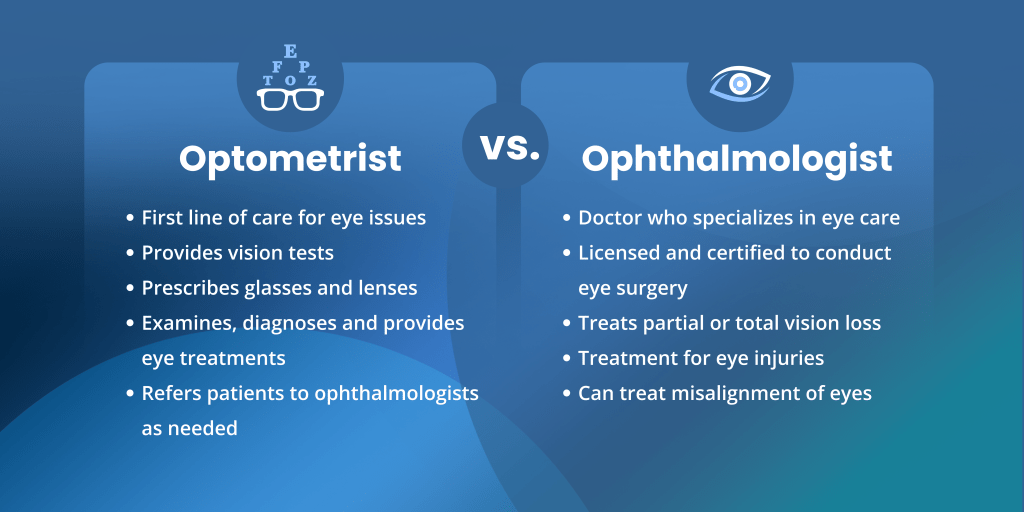
Optometrist vs. Ophthalmologist: Types of Eye Doctors
Explore the different types of vision care doctors and how to pursue a medical specialization in this field.
According to the World Health Organization, at least 2.2 billion people globally have a vision impairment or blindness, underscoring the critical need for eye care professionals. For aspiring medical students, the world of eye care offers a fascinating array of career paths – each with its own unique blend of science, patient interaction and impact.
Two of the most prominent roles in this field are optometrists and ophthalmologists. In this blog, we’ll explore the optometrist vs ophthalmologist differences, breaking down their roles, training and career prospects to help you find the path that’s right for you.
What is an Optometrist?
An optometrist is a healthcare professional who provides primary vision care. They are trained to examine, diagnose and manage common vision issues and eye conditions.
With a Doctor of Optometry (OD) degree, these specialists focus on routine eye health – think eye exams, prescribing glasses or contact lenses, and detecting abnormalities like glaucoma or cataracts.
They’re your first line of defense for maintaining clear vision and often collaborate with other healthcare providers to ensure holistic care.
What is an Ophthalmologist?
An ophthalmologist is a medical doctor specializing in eye and vision care. They have completed medical school, followed by a residency in ophthalmology.
Ophthalmologists are qualified to perform eye exams, diagnose eye diseases and even perform surgery. These professionals are equipped to handle everything from prescribing corrective lenses to performing intricate procedures like cataract removal or LASIK.
With their advanced training, ophthalmologists tackle complex eye diseases and injuries, making them vital for patients with severe conditions.
What is the Difference Between an Optometrist and an Ophthalmologist?
The optometrist vs ophthalmologist distinction boils down to education, scope and approach.
Optometrists focus on primary care and non-surgical treatments, earning a Doctor of Optometry (OD) degree after four years of optometry school. Ophthalmologists, however, are physicians who complete medical school and a residency, enabling them to perform surgery and treat advanced eye diseases.
While both are essential types of eye doctors, optometrists serve as gatekeepers – screening and referring – while ophthalmologists step in for specialized or surgical intervention. This collaborative dynamic ensures patients receive the right care at the right time.

Educational Pathway and Training
Becoming an Optometrist
There are three key steps to become an optometrist:
- Undergraduate Education: Aspiring optometrists must complete a bachelor’s degree, often with a focus on pre-medical or biological sciences.
- Optometry School: After undergraduate studies, candidates enroll in a four-year Doctor of Optometry (OD) program.
- Licensing: Graduates must pass the National Board of Examiners in Optometry (NBEO) exams to obtain licensure to practice.
Some optometrists choose to pursue additional residency training in specialized areas such as pediatric optometry or ocular disease.
Becoming an Ophthalmologist
The path to becoming an ophthalmologist is more extensive:
- Undergraduate Education: Completion of a bachelor’s degree with a strong emphasis on pre-medical courses.
- Medical School: Four years of medical school to earn a Doctor of Medicine (MD) or Doctor of Osteopathic Medicine (DO) degree. During medical school, students may have the opportunity to take part in specialized elective ophthalmology rotations.
- Residency: A residency program (generally four years in duration) in ophthalmology, providing intensive training in medical and surgical eye care.
- Fellowship (optional): Additional subspecialty training in areas like retinal surgery or pediatric ophthalmology.
This extensive training path equips ophthalmologists with the expertise to manage complex eye conditions and perform advanced surgical interventions, positioning them as leaders in the field of eye care.
Scope of Practice and Specializations
Optometry Practice Scope
Optometrists provide a range of services, including:
- Conducting comprehensive eye exams.
- Prescribing and fitting eyeglasses and contact lenses.
- Diagnosing and managing common eye conditions like dry eye syndrome and conjunctivitis.
- Providing vision therapy and low vision rehabilitation.
Some optometrists may specialize in areas such as pediatric optometry, geriatric optometry or contact lens fitting.
Ophthalmology Practice Scope
Ophthalmologists offer comprehensive eye care services, including:
- Performing complex eye surgeries, such as cataract extraction and laser eye surgery.
- Diagnosing and treating serious eye diseases like glaucoma, macular degeneration and diabetic retinopathy.
- Providing medical interventions for eye injuries and infections.
Subspecialties within ophthalmology include:
- Pediatric Ophthalmology: Focusing on eye conditions in children.
- Neuro-Ophthalmology: Dealing with vision problems related to the nervous system.
- Ocular Oncology: Specializing in eye cancers.
Responsibilities of an Optometrist and Ophthalmologist
Optometrists and ophthalmologists share a commitment to eye health but with distinct responsibilities.
Optometrists handle routine exams, vision testing and prescribing corrective lenses, often managing chronic conditions like dry eye. Ophthalmologists take on advanced diagnostics, surgical interventions and treatment of severe diseases, while also training future specialists.
Collaboration between the two is common, ensuring patients receive comprehensive care that is tailored to their needs.
Optometrist vs Ophthalmologist Salary, Career Outlook and Opportunities
Optometrist Career Path and Salary
The career outlook for optometrists is promising, with the U.S. Bureau of Labor Statistics projecting steady growth in demand through 2032. This growth is driven by an aging population and an increased prevalence of chronic conditions that impact eye health. Other countries report similar projections.
The average optometrist salary in the United States is around $125,000 USD per year, though this figure can vary depending on geographic location, years of experience and specialization. The profession offers a balanced lifestyle with fewer emergency demands compared to other medical fields, making it an attractive option for those seeking both professional fulfilment and personal flexibility.
Ophthalmologist Career Path and Salary
A career in ophthalmology offers high earning potential, intellectual stimulation and the ability to make life-changing differences for patients. The demand for ophthalmologists is also expected to rise, with increased longevity and advancements in eye surgery fuelling the need for specialists in this field.
The average salary for ophthalmologists in the U.S. is around $335,000 USD per year, placing them among the highest-earning medical professionals. Those in private practice or surgical subspecialties often earn significantly more, especially when combined with research or academic appointments. The career path is demanding but deeply rewarding, offering a dynamic blend of patient care and continuous learning in a technologically evolving field.
Types of Eye Care Specialists
While the comparison of optometrist vs ophthalmologist is crucial for aspiring practitioners, understanding all the different types of eye doctors helps round out the picture of vision care careers.
An optician is a trained technician who fits and dispenses eyeglasses and contact lenses based on prescriptions from optometrists or ophthalmologists. While they don’t diagnose or treat eye conditions, opticians play a vital role in patient care by ensuring that corrective lenses meet the visual and lifestyle needs of each individual. The comparison of optician vs. optometrist highlights the difference between a technical role and a clinical one.
There are also other vision specialists, such as orthoptists (who work with eye movement disorders), vision therapists and ocularists (who make prosthetic eyes). Each of these professionals plays a unique part in the broader field of vision care, supporting patients across various stages of treatment and recovery.
Understanding the types of eye doctors can help you determine where your interests lie and what role best aligns with your aspirations in medicine.
Choosing the Right Path: Key Considerations for Medical Students
Whether you’re interested in primary vision care or complex surgical interventions, your future in eye health starts with understanding what each role entails. If you’re motivated by the opportunity to build long-term relationships with patients and help manage day-to-day vision needs, optometry may be a great fit. If you’re drawn to surgery, in-depth diagnostics and long-term disease management, ophthalmology offers a more intensive but lucrative medical path.
At Saba University School of Medicine (SUSOM), we’re committed to helping students build careers rooted in purpose, opportunity and clinical success. Discover why SUSOM is a great choice for students aiming for a career in specialized fields like ophthalmology, where our partnerships, such as our collaboration with Carrot Health, provide real-world experience in eye surgery and advanced care.
Ready to take the next step? Learn more about our MD program and start shaping your future in medicine today.
You can also learn more about our medical education and student outcomes in this alum testimonial video:
Then contact us with any questions or start your application today!
FAQs About Vision Care Doctors
Ophthalmologists typically earn between $250,000 and $400,000 USD annually in the U.S., depending on experience, location and subspecialty. Surgeons in high-demand fields like retina or oculoplastics may earn even more. Their income reflects the extensive training they undertake and complex procedures they perform.
Optometrists are not medical doctors, but they are licensed healthcare professionals with a Doctor of Optometry (OD) degree. They are trained to provide comprehensive eye exams, diagnose some eye diseases and prescribe corrective lenses. However, they do not perform surgery or treat more complex medical conditions like ophthalmologists.
It typically takes 12 to 14 years to become an ophthalmologist. This includes four years of undergraduate education, four years of medical school, four years in an ophthalmology residency program. Additional fellowship training can add one to two more years for subspecialties.
The highest level of eye doctor is an ophthalmologist. They are medical doctors who can diagnose and treat all eye diseases, perform surgery and prescribe medications. Within ophthalmology, some professionals pursue subspecialties that require even more advanced training and certification.

For Prospective Students
SUSOM is committed to supporting prospective students throughout the admissions process. Please click the following links for detailed information about each topic: